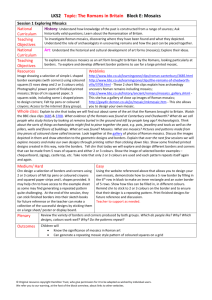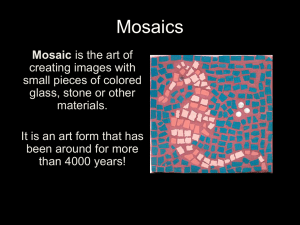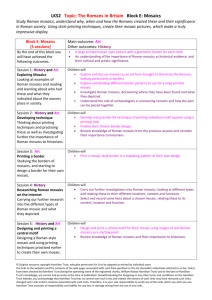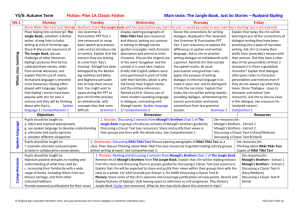Session 05 - Hamilton Trust
advertisement
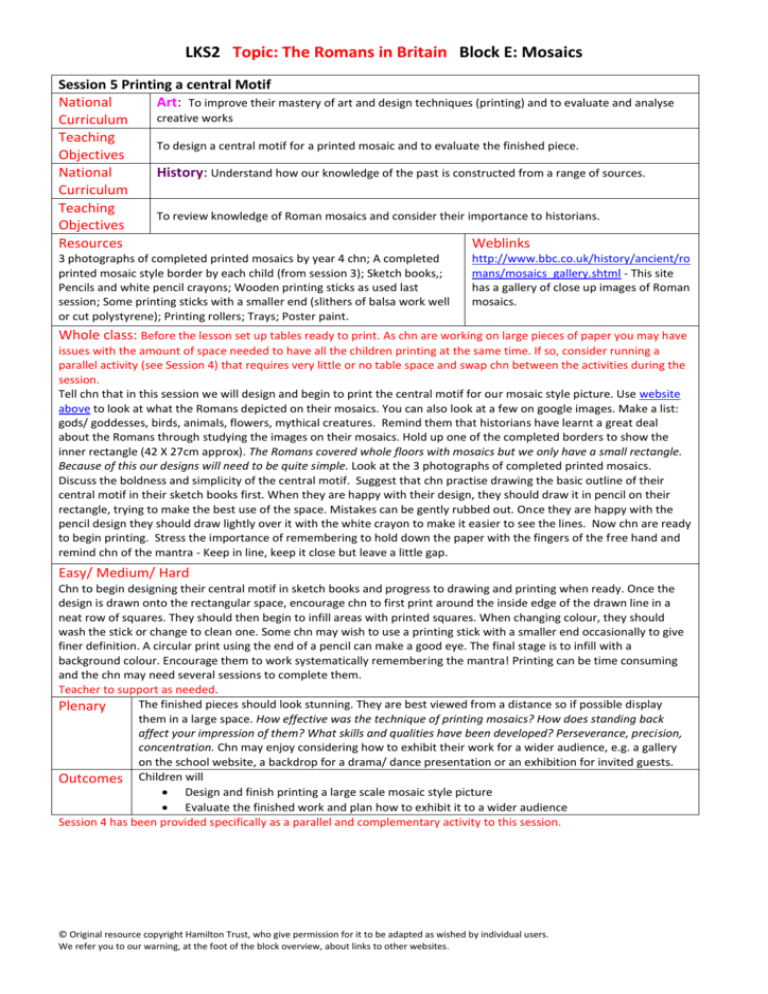
LKS2 Topic: The Romans in Britain Block E: Mosaics Session 5 Printing a central Motif National Art: To improve their mastery of art and design techniques (printing) and to evaluate and analyse creative works Curriculum Teaching To design a central motif for a printed mosaic and to evaluate the finished piece. Objectives National History: Understand how our knowledge of the past is constructed from a range of sources. Curriculum Teaching To review knowledge of Roman mosaics and consider their importance to historians. Objectives Resources Weblinks 3 photographs of completed printed mosaics by year 4 chn; A completed printed mosaic style border by each child (from session 3); Sketch books,; Pencils and white pencil crayons; Wooden printing sticks as used last session; Some printing sticks with a smaller end (slithers of balsa work well or cut polystyrene); Printing rollers; Trays; Poster paint. http://www.bbc.co.uk/history/ancient/ro mans/mosaics_gallery.shtml - This site has a gallery of close up images of Roman mosaics. Whole class: Before the lesson set up tables ready to print. As chn are working on large pieces of paper you may have issues with the amount of space needed to have all the children printing at the same time. If so, consider running a parallel activity (see Session 4) that requires very little or no table space and swap chn between the activities during the session. Tell chn that in this session we will design and begin to print the central motif for our mosaic style picture. Use website above to look at what the Romans depicted on their mosaics. You can also look at a few on google images. Make a list: gods/ goddesses, birds, animals, flowers, mythical creatures. Remind them that historians have learnt a great deal about the Romans through studying the images on their mosaics. Hold up one of the completed borders to show the inner rectangle (42 X 27cm approx). The Romans covered whole floors with mosaics but we only have a small rectangle. Because of this our designs will need to be quite simple. Look at the 3 photographs of completed printed mosaics. Discuss the boldness and simplicity of the central motif. Suggest that chn practise drawing the basic outline of their central motif in their sketch books first. When they are happy with their design, they should draw it in pencil on their rectangle, trying to make the best use of the space. Mistakes can be gently rubbed out. Once they are happy with the pencil design they should draw lightly over it with the white crayon to make it easier to see the lines. Now chn are ready to begin printing. Stress the importance of remembering to hold down the paper with the fingers of the free hand and remind chn of the mantra - Keep in line, keep it close but leave a little gap. Easy/ Medium/ Hard Chn to begin designing their central motif in sketch books and progress to drawing and printing when ready. Once the design is drawn onto the rectangular space, encourage chn to first print around the inside edge of the drawn line in a neat row of squares. They should then begin to infill areas with printed squares. When changing colour, they should wash the stick or change to clean one. Some chn may wish to use a printing stick with a smaller end occasionally to give finer definition. A circular print using the end of a pencil can make a good eye. The final stage is to infill with a background colour. Encourage them to work systematically remembering the mantra! Printing can be time consuming and the chn may need several sessions to complete them. Teacher to support as needed. The finished pieces should look stunning. They are best viewed from a distance so if possible display Plenary them in a large space. How effective was the technique of printing mosaics? How does standing back affect your impression of them? What skills and qualities have been developed? Perseverance, precision, concentration. Chn may enjoy considering how to exhibit their work for a wider audience, e.g. a gallery on the school website, a backdrop for a drama/ dance presentation or an exhibition for invited guests. Outcomes Children will Design and finish printing a large scale mosaic style picture Evaluate the finished work and plan how to exhibit it to a wider audience Session 4 has been provided specifically as a parallel and complementary activity to this session. © Original resource copyright Hamilton Trust, who give permission for it to be adapted as wished by individual users. We refer you to our warning, at the foot of the block overview, about links to other websites.
